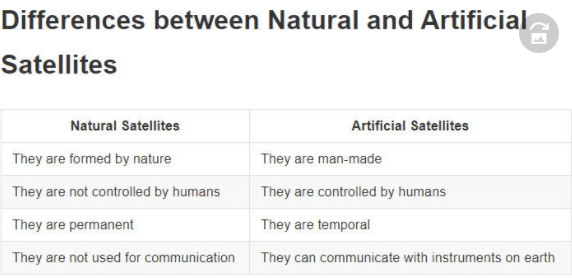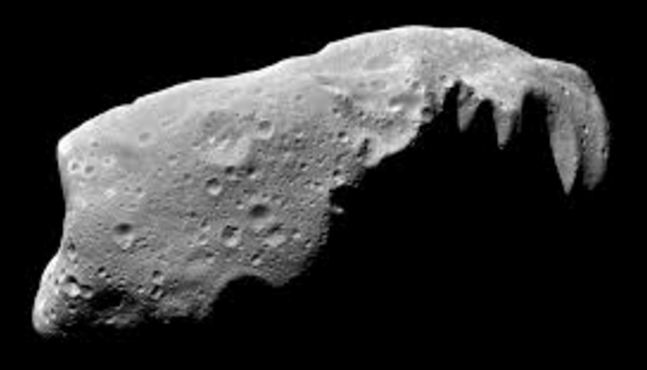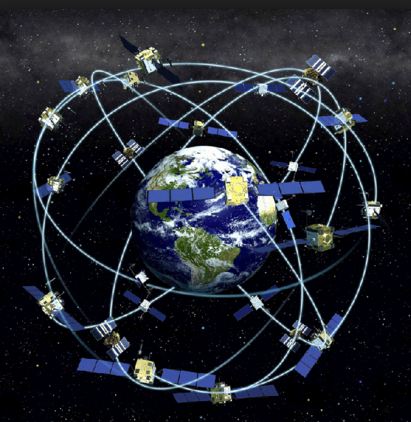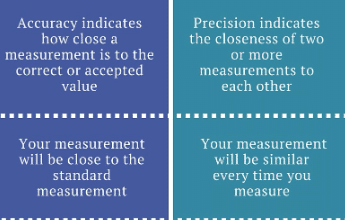
The difference between natural and artificial satellites is provided here. Enter and learn brief differences between Natural satellites and artificial satellites with examples.
Keep reading…..
What is the satellite?
Any heavenly body that moves around a planet s called a satellite. The Moon is a natural satellite of the Earth that orbits the Earth. Mars, Jupiter, Saturn, Uranus, and Neptune have their own satellites too.
Natural Satellites
Besides the moons of the planets, some other natural satellites are also moving around the Sun. These are asteroids, comets, and meteoroids. Some of them can be seen from the Earth.
Name the natural satellite of the earth
- Asteroids
- Moon
- Comets
- meteors
Difference between asteroid and comet
Asteroids
An asteroid is a piece of rock that orbits the Sun between Mars and Jupiter. Astronomers have discovered thousands of asteroids. Asteroids are made of rock, metals, and minerals.
Most of the asteroids orbit the Sun between Mars and Jupiter in a wide band. This band is called the asteroid belt. The asteroid belt is about 15 hundred thousand kilometers wide. Asteroid comes in all shapes and sizes. Some asteroids have a diameter of up to 1,000 kilometers but some are very small in diameter.
Two asteroids are seen from the Earth without the help of a telescope. These are Ceres and Vesta. Ceres is the largest asteroid ever discovered. Its diameter is about 933 kilometers. Vesta is half the size of Ceres.
A question may arise in our minds, “how were asteroids formed?” Some astronomers suggest that asteroids are a leftover matter from the time the planets were formed. We can say that asteroids, maybe the pieces of our solar system never formed a planet.
Comets
Besides planets and asteroids, some other objects also orbit the Sun. These are comets. A comet is a large ball of ice and dust that orbits the Sun. Comets move around the Sun in an elliptical path. They take a very long time to complete their one orbit around the Sun.
Comets probably come from the far, outer edges of the solar system. They are only seen when they come close to the Sun.
- A comet has three parts: a head, a coma, and a tail the head is made of ice, particles of rocks, and gases. The heads are most comets are only a few kilometers wide.
- When a comet comes near the Sun, gases escape from its head due to the heat of the Sun. A large fuzzy, circular cloud around the head of a comet is called the coma.
- During orbiting near the Sun, a long tail of gases and dust particles is formed behind the comet. This tail can be millions of kilometers long. The tail of a comet points away from the Sun.
- Comets far away from the Sun bear no tail. Most of the time comets remain far away from the Sun.
A comet known as Comet Halley has appeared in the sky many times. It appears after every 76 years. It was seen in 1986 for the last time. When can we expect to see Comet Halley?
Difference between asteroid and meteor
Meteors
An uncountable number of small heavenly bodies also orbit the Sun. These are called meteoroids. A meteoroid is a piece of rock or metal that orbits the Sun. Meteoroids are scattered in different orbits in space. Most of them are too small to be seen from the Earth.
Have you ever seen a shooting star or fireball in the sky? In fact, it is no star but a meteoroid entering the atmosphere of the Earth. Due to the friction of air, it gets fire.
A meteoroid when enters the atmosphere of our Earth. It is called a meteor. A meteor is a stray particle that comes from the asteroid belt and enters the atmosphere of the Earth. Due to the friction of air, the meteor gets fire and a trail of light is seen. Some people call them falling stars, shooting stars, or fireballs. We can view 20 to 30 meters on a clear night. But we have to move away from the glare of city lights.
Most meteors entering our atmosphere burn up 50 to 100 kilometers above the surface of the Earth. It adds tons of dust to our atmosphere every day.
Sometimes a few big enough meteoroids do strike Earth’s surface. These are called meteorites. A meteorite is a meteor that strikes Earth’s surface.
Artificial Satellites
There are many man-made satellites orbiting the Earth. These are called artificial satellites. Artificial satellites are very important for mankind. The first artificial satellite was sent by Russia in 1957. It was named Sputnik-1. The launching of this satellite opened new horizons for Scientists. After a few years after launching Sputnik-1, Russia sent Yuri Gagarin, the first man into space. Since then, thousands of satellites have been sent into space.
Examples of artificial satellites
- Geostationary satellites
- Landsat satellites
- Polar satellites
- Communication satellites
Orbits of Artificial satellites:
Artificial satellites move around the Earth in different orbits. Some orbits are given here:
Geostationary orbit:
The orbit in which an artificial satellite completes its one orbit in the same time that the Earth takes to complete one spin,i.e.24 hours, is called geostationary orbit. A satellite in this orbit looks stationary from the Earth.
Polar orbit:
Polar orbit passes over the north and south poles of the Earth.so, satellites moving in this orbit can scan the whole Earth during their motion.
Eccentric orbit:
The scientific satellites move in eccentric orbits to measure the magnetism and electric fields of the Earth.
Low Earth orbit:
This orbit is very close to the Earth. Low Earth orbit is used by space shuttles, space stations, and the Hubble telescope. these satellites may orbit the very 90 minutes.
State receiving station:
A station on the Earth that receives messages from satellites is called a satellite receiving station.
Launching of a satellite into space:
Launching of an artificial satellite into space is not very easy. This project requires a lot of money. The satellite is mounted on the top of a very high-speed rocket. A rocket has many parts. Each part of the rocket falls off after pushing the satellite through the atmosphere into space. After a certain period of time, all the artificial satellites will burn up like meteors.
list of Key Milestones in Space Technology:
Here is a look at some of the key milestones in space technology:
October 4, 1957: soviet Union launches Sputnik-1.
January 4, 1958: United Space launches explorer 1.
April,12,1961: Yuri Gagarin becomes the first human to enter space and
Return safely.
July 18, 1969: launch of Apollo 11. It puts the first space station, the Skylab.
May 14, 1973: the United States launches its first space station, the Skylab.
June 18, 1983: Sally ride becomes the first American woman in space.
February 19, 1986: Mir space station launches.
September 30, 2003: First privately-owned spaceship launches.
August 4, 2007: Phoenix lander lands on Mars.
Kinds of Artificial Satellites:
The scientist has sent many satellites that move around the Earth. These satellites help scientists to learn about weather and many more things on the Earth.
Sputnik:
On October 4, 1957, Russia sent the world’s first artificial satellites, sputnik-1 into space. The name comes from a Russian word for “traveling companion of the world.” It weighed just 83 kg. It carried a thermometer and two radio transmitters which sent information about the atmosphere to the Earth. Its two transmitters only functioned for 21 days. After 57 days in orbit, it was destroyed.
Explorer 1:
Explorer 1 was the first satellite b launched by the united states of America. It was sent into space on January 31, 1958. It weighed only 14kg. Explorer 1 sent information about the radiation environment in the Earth’s orbit.
Geostationary Satellites
Geostationary satellites move at a height of about 36,000 km above the Earth. At this height, they move around the Earth at the same speed as the Earth moves around its axis. This satellite seems to be stationary. They are used as communication satellites. Pakistan launched its first geostationary satellite, PAKISTAN-1R on August 11, 2011.
Landsat satellites:
The land lies is a series of os satellite missions. Since 1972, land-set satellites have collected information about Earth from space. Landsat satellites have taken photographs of Earth’s continents and surrounding coastal regions.
Communication satellites
Communication satellites have a great effect on our daily lives. They link remote areas on the Earth with telephones and television. Newspapers are typed and transmitted to putting machines via satellite in some countries.
Polar Satellite
The polar satellite was launched on February 24, 1996, by America. Polar satellites study the atmosphere of the Earth in polar orbit after every 18 hours. The polar satellite will help scientists to protect future satellites from atmospheric dangers.
Global Positioning System
Satellites have improved our knowledge about space and even about our Earth. Using satellites, you can find your position anywhere in the world accurate to 10m or less. Locating the position of objects with the help of a satellite is called the global positioning system or GPS. It is freely accessible by anyone with a GPS receiving.
Visiting The Space:
- In 1969, two Americans were the first men to step on the Moon. They were Neil Armstrong and Edwin Aldrin.
- India sent her first satellite Aryabhatta into space in 1975.
- Pakistan sent her satellite Badr-1 in 1990s.
Suggested Topics:

Informative thanx
you are welcome,